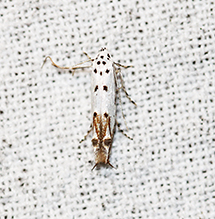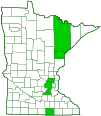Red-streaked mompha moth
(Mompha eloisella)
Conservation • Description • Habitat • Ecology • Distribution • Taxonomy
| Hodges # | 1443 |
||
Conservation Status |
|||
| IUCN Red List | not listed |
||
| NatureServe | NNR - Unranked |
||
| Minnesota | not listed |
||
Description |
Red-streaked mompha moth is a small, easily recognized, stem-boring, curved-horn moth. It occurs in the United States and southern Canada east of the Great Plains and on the West Coast, with just a few scattered records between. Adults are active from June to August. They are found in open areas wherever their host plants occur, including in meadows, power-line corridors, and abandoned fields, at the edges of agricultural fields, on roadsides, and in other disturbed sites. The larvae bore into the stems of evening primrose. They have been recorded on bigfruit evening primrose and common evening primrose. Adults are highly variable in size. They range in length from ¼″ to 5⁄16″ (6 to 8 mm). The forewing length varies from ⅛″ to 5⁄16″ (4 to 8 mm), but it is usually closer to 5⁄16″ (8 mm). The wingspan varies from 5⁄16″ to ⅝″ (8 to 15 mm), but it is usually closer to ⅝″ (15 mm). The head and face are silvery white. The finger-like sensory organs (labial palps) attached to the mouth are white and very long, and there is a dark brown spot in the middle of the second segment. The palps curve upward in front of the head well beyond the middle of the face. The antennae are long and slender. The forewings are narrow and silvery white with black spots. Each forewing has several black spots near the base and a single black spot in the median area. Two reddish, oblique lines on the rear half form a forward-pointing, V-shape. This is the feature that gives the species its common name. There is a small tuft of dark scales at the base of the V, and another larger tuft of scales near the wingtip. There is one blackish and several brownish, oblique streaks on the leading edge (costal margin) on the rear third of the wing, and one blackish streak at the middle. Hairs on the fringe form a long, tail-like tip to the forewing. The legs are white with black blotches. |
Size |
Total length: ¼″ to 5⁄16″(6 to 8 mm) Forewing length: ⅛″ to 5⁄16″ (4 to 8 mm) Wingspan: 5⁄16″ to ⅝″ (8 to 15 mm) |
Similar Species |
Habitat |
Open areas, including meadows, power lines, abandoned fields, agricultural fields, roadsides, and other disturbed sites |
Ecology |
Season |
June to August |
Behavior |
Adults are attracted to lights. |
Life Cycle |
The larva bores into a stem of evening primrose. Before reaching maturity, the larva constructs a cell in which it hibernates over the winter. In April or May the following spring, it spins a cocoon, partially exposed on the outside of the stem, in which it pupates. The adult emerges in June or July. |
Larva Hosts |
bigfruit evening primrose (Oenothera laciniata) |
Adult Food |
|
Distribution |
||
|
Sources |
|
| 9/13/2025 | ||
Occurrence |
||
Common |
||
Taxonomy |
|
Order |
|
Superfamily |
Gelechioidea (curved-horn moths) |
Family |
Momphidae |
Subfamily |
Momphinae |
Genus |
Mompha |
Subordinate Taxa |
|
|
|
Synonyms |
|
Laverna eloisella Laverna lyonetiella Laverna magnatella Laverna oenotheraeella Phyllocnistis magnatella |
|
Common Names |
|
red-streaked mompha red-streaked mompha moth |
|
Glossary
Costal margin
The leading edge of the forewing of insects.
Palp
Short for pedipalp. A segmented, finger-like process of an arthropod; one is attached to each maxilla and two are attached to the labium. They function as sense organs in spiders and insects, and as weapons in scorpions. Plural: palpi or palps.
Visitor Photos
Share your photo of this insect.
This button not working for you?
Simply email us at info@MinnesotaSeasons.com.
Attach one or more photos and, if you like, a caption.
Gary Walton |
 |
Many Oenothera biennis plants nearby. |
MinnesotaSeasons.com Photos
|

Slideshows

Visitor Videos
Share your video of this insect.
This button not working for you?
Simply email us at info@MinnesotaSeasons.com.
Attach a video, a YouTube link, or a cloud storage link.
Other Videos



